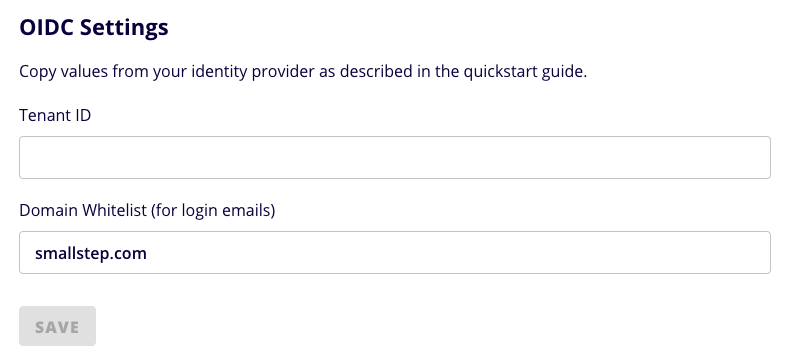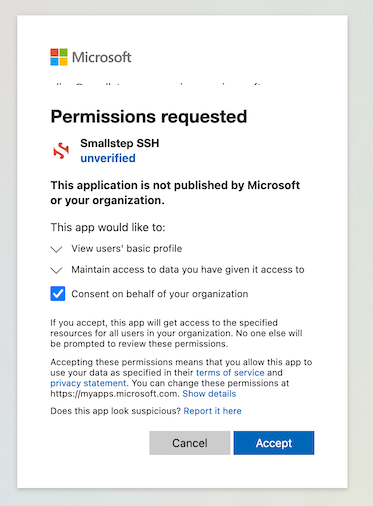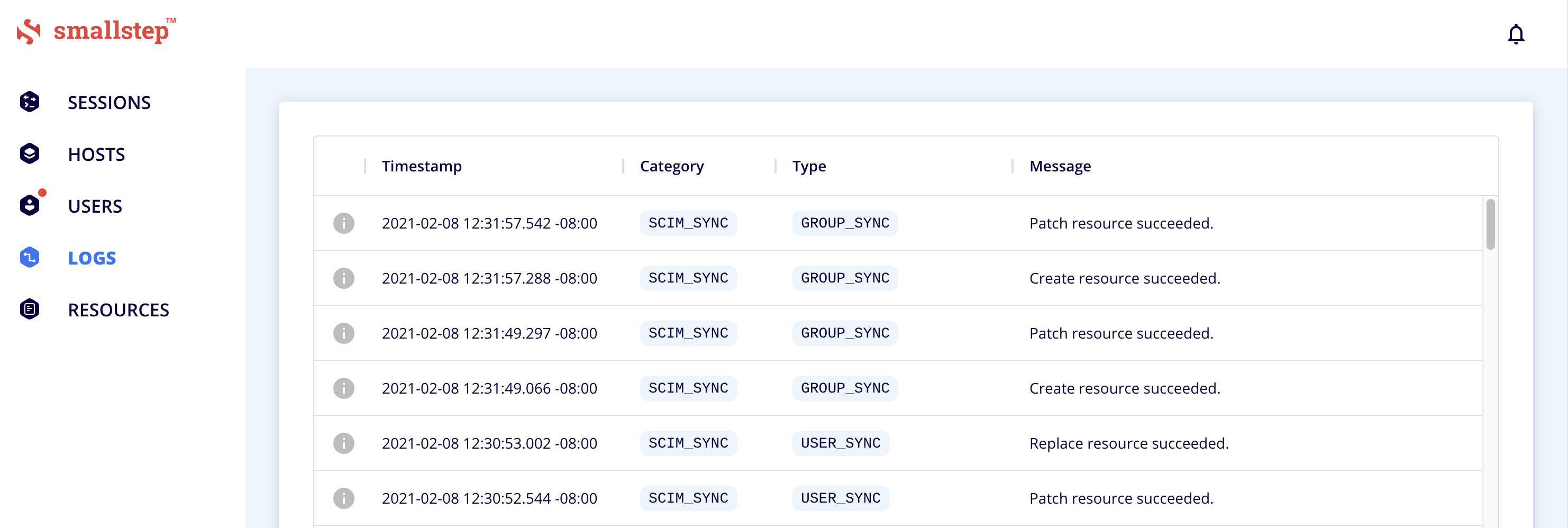Menu
Products
Open Source
- Configure popular ACME clients to use a private CA
- Use Kubernetes cert-manager with
step-ca - Issue X.509 host certificates to cloud VMs
- Issue X.509 user certificates via your identity provider
- Create a CA that uses RSA keys
- Import an existing root or intermediate CA into
step-ca - Use Keycloak to issue SSH certificates with step-ca
- Run an SSH CA and connect to VMs using SSH certificates
- Use AWS to deploy a certificate authority and secure microservices
- Run
step-cain a Docker container - Federate multiple autonomous certificate authorities
Products
Open Source
- Configure popular ACME clients to use a private CA
- Use Kubernetes cert-manager with
step-ca - Issue X.509 host certificates to cloud VMs
- Issue X.509 user certificates via your identity provider
- Create a CA that uses RSA keys
- Import an existing root or intermediate CA into
step-ca - Use Keycloak to issue SSH certificates with step-ca
- Run an SSH CA and connect to VMs using SSH certificates
- Use AWS to deploy a certificate authority and secure microservices
- Run
step-cain a Docker container - Federate multiple autonomous certificate authorities
Azure AD Quickstart
Prerequisites
You will need:
- An account on the smallstep platform. Need one? Register here
- An Azure Premium edition account (P1 or higher)
- Global administrator access to the account
Features
The following provisioning features are supported:
- Push Groups and New Users
- Push Profile or Group Updates
- Push User Deactivation
- Reactivate Users
Overview
- Create Groups in Azure Active Directory
- Tell us your directory's Tenant ID
- Add the Smallstep SSH Azure Enterprise Application to your tenant
- Enable user provisioning (SCIM) in Azure
- Check logs to confirm users and groups are syncing to Smallstep SSH
Step By Step Instructions
Step 1. Create Groups
You'll grant access to your hosts via Active Directory Groups. If you don't already have groups set up, you'll want to create a group for each kind of user access to your servers. For example, you might have a group for ssh users, and one for sudo users.
In the Azure portal, start at the Groups blade.

When creating your groups, give them names and accept the defaults on all other settings.
Step 2. Tell us your directory's Tenant ID
In the Smallstep SSH dashboard, under the Users tab, choose Azure.
Paste your Tenant ID from the Active Directory Overview blade into the "Add Your Team" dialog:

Choose Save.
Step 3. Add the Smallstep SSH Azure Enterprise Application
Sign in to Smallstep SSH
Sign in to Smallstep at
https://smallstep.com/app/[Team ID]Follow the Getting Started workflow.
Choose the Users tab, and choose Azure AD as your identity provider.
Enter your Tenant ID and Whitelisted Domains, and Save.
Now run
step ssh login your@email. Your browser will open to an Azure AD single sign-on flow, and you'll be prompted to add the Smallstep SSH enterprise application to your tenant.
Choose Consent on behalf of your organization.
Accept the application for your tenant, and finish the sign-on flow.
🤦♂️ If you encounter "The username may be incorrect", you'll need to use a different account to accept the application into your tenant. Specifically, you cannot use a Microsoft Account or a Guest account; the account must be an Azure AD account.
Assign groups to your application
In the Azure Portal Enterprise Applications blade, you should now see Smallstep SSH. Open it.
Choose Users and Groups on the left:
- Go to + Add User to create a new assignment.
- Select the groups you created in Step 1.
- Choose Select on the bottom right.
- Choose Assign on the bottom left.
Your Users and Groups list should now look something like this:

Step 4. Enable user provisioning (SCIM) in Azure
- Choose Provisioning on the left and choose Get Started.
- Set the provisioning mode to Automatic.
- Expand Admin Credentials:
- Supply the SCIM Tenant URL and Secret Token from the Smallstep dashboard.
- Choose Test Connection and make sure that it works.
- Save.
Alternative
userNameAttribute MappingsThe
userNameattribute determines the name of the POSIX account that will be created when users connect to a host. By default, the expression returns the everything before the@in the UPN, converted to lowercase:ToLower(Replace([userPrincipalName], , "(?<Suffix>@(.)*)", "Suffix", "", , ), )Here are some alternative UPN expressions that have been useful to customers:
Remove dots
.from usernamesSome users have dotted UPNs, and POSIX usernames without dots. Linux usernames with
.in them are POSIX-compliant (IEEE Std 1003.1-2017, section 3.437) and in practice dotted usernames work fine on many systems. If your UPNs contain dots, you can configure theuserNameattribute mapping to remove them. Use the following expression for youruserNameattribute:ToLower(Replace(Replace([userPrincipalName], , "(?<Suffix>@(.)*)", "Suffix", "", , ), ".", , ,"", , ))Convert
bill.gates@microsoft.comtobgates:ToLower(Replace(Replace([userPrincipalName], , "(?<=^.{1}).\w+.\.", "", "", , ), , "(@(.)*)","","" , ,))
Turn on Provisioning
- Save your settings and return to the Provisioning panel.
- Choose Start Provisioning.
🤦♂️ There's a quirk in Microsoft's UI here, and you may see an error when saving after turning provisioning on. If so, wait 60 seconds and try Save again.
Step 5. Confirm the directory connection
Return to the Smallstep dashboard.
Navigate to the LOGS menu. You should see a list of success messages assocated with
SCIM-SYNCcatagory items.
Navigate to the USERS menu. If the onboarding dialog is open, press
Escto close.You should see your Users and Groups synced over from Azure AD.
Don't see your users and groups? Microsoft's SCIM service may add a 40-minute delay after you set it up. You can force an update by clicking Restart provisioning in the Provisioning panel. Even then, it may take a minute to sync with Smallstep.
Azure AD Configuration Complete
Troubleshooting Tips
- Initial activation of Azure AD OIDC provisioning in Smallstep SSH requires entering your Application (client) ID, Client secret, and Configuration Endpoint into the Smallstep UI. Contact smallstep support with any questions | support@smallstep.com
- Note: When users are deactivated in Azure AD, they will be deactivated in Smallstep. Users will not be able to SSH to servers, but their user accounts will remain on smallstep managed hosts. To permanently delete user data on smallstep managed hosts, contact Smallstep Support | support@smallstep.com
Subscribe to updates
Unsubscribe anytime. See our privacy policy.
© 2023 Smallstep Labs, Inc. All rights reserved.